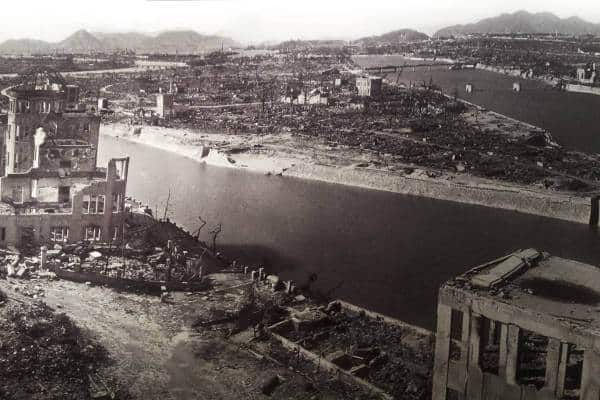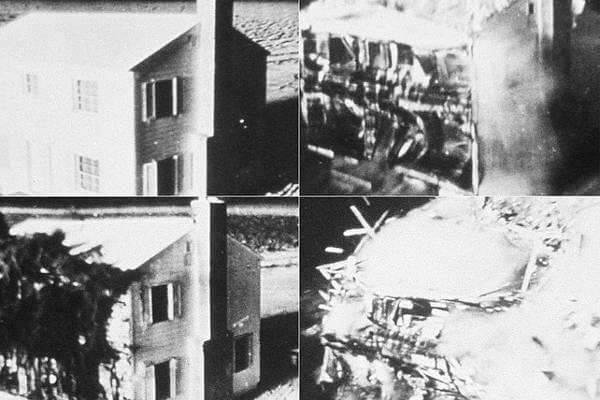Nuclear weapons have been used twice, on the Japanese cities of Hiroshima and Nagasaki in August 1945. Evidence from these occasions, as well as atmospheric nuclear testing and nuclear power accidents have formed the basis of our knowledge of the effects of nuclear weapons. Modern nuclear weapons generally have much greater explosive power than those first two bombs, and would greatly increase the scale of the devastation.
Join CND to campaign against nuclear weapons

The effects can be divided into four categories: instantaneous, near-immediate, short term and long term.
Instantaneous
The heart of a nuclear explosion reaches a temperature of several million degrees centigrade. Over a wide area the resulting heat flash literally vaporises all human tissue. At Hiroshima, within a radius of half a mile, the only remains of most of the people caught in the open were their shadows burnt into stone.
Near-immediate
People inside buildings or otherwise shielded will be indirectly killed by the blast and heat effects as buildings collapse and all inflammable materials burst into flames. The immediate death rate will be over 90%. Various individual fires will combine to produce a fire storm as all the oxygen is consumed. As the heat rises, air is drawn in from the periphery at or near ground level. This results in lethal, hurricane force winds as well as perpetuating the fire as the fresh oxygen is burnt. Such fire storms have also been produced by intense, large scale conventional bombing in cities such as Hamburg and Tokyo.
People in underground shelters who survive the initial heat flash will die as all the oxygen is sucked out of the atmosphere.
Outside the area of total destruction there will be a gradually increasing percentage of immediate survivors. However most of these will suffer from fatal burns, will be blinded, bleeding from glass splinters and will have suffered massive internal injuries. Many will be trapped in collapsed and burning buildings. The death rate will be higher than in a normal disaster since most emergency services will be incapable of responding due to their equipment being destroyed and staff killed. The sheer scale of the casualties would overwhelm any country’s medical resources. The International Red Cross has concluded that the use of a single nuclear weapon in or near a populated area is likely to result in a humanitarian disaster that will be “difficult to address”. There is currently no international plan in place to deliver humanitarian assistance to survivors in the case of a nuclear attack. Most casualties would receive at best minimal, palliative treatment. The best they could hope for would be to die in as little pain as possible.

Short Term
Survivors will be affected within a matter of days by radioactive fall-out. The extent of the fall-out will vary according to whether the nuclear bomb detonates in the air (as at Hiroshima) or upon impact on the ground. While the former will entail more blast impact, the latter will throw up much larger quantities of radioactive debris into the atmosphere.
The area covered by the fall-out is determined by wind speed and direction. The heavier particles of radioactive material will fall in the immediate or close vicinity. Finer particles will be blown over longer distances before they descend. Very fine particles may be blown even further before they combine with water vapour and fall as radioactive rain. In the aftermath of the Chernobyl nuclear power explosion and fire in the Ukraine in 1986, radioactive rain fell over the next few days in a wide arc across Northern Europe, from Scandinavia to Scotland, Cumbria and Wales, a distance of over 1,700 miles from Chernobyl.
The effects of exposure to high levels of radioactive fall-out include hair loss, bleeding from the mouth and gums, internal bleeding and hemorrhagic diarrhoea, gangrenous ulcers, vomiting, fever, delirium and terminal coma. There is no effective treatment and death follows in a matter of days.
At lower levels of exposure, while there is an increased chance of at least short term survival, the death rate remains high. Those who do survive face many complications. Pregnant women are likely to miscarry or give birth to babies with a range of disabilities. Healing from injuries is often slow, leaving distinctive scar tissue. Damage to the immune system is probable.
Long Term
Radiation-induced cancers will affect many, often over twenty years later. Certain cancers such as thyroid cancer in children are particularly associated with exposure to radiation. The children of those exposed to radiation are statistically more likely to be born with abnormalities and suffer from leukaemia. Because of the long period between exposure and the onset of cancer, it is difficult to attribute a particular cancer to a particular cause. The correlation is described as epidemiological, rather as the connection between smoking and lung cancer was statistically established before the medical links had been uncovered.
Accurate estimates of long term fatalities at Hiroshima and Nagasaki are not possible given the large scale destruction of records, population movements and a general censorship on nuclear effects by the US occupation regime. However the generally used estimates of casualties are 140,000 in Hiroshima and 75,000 in Nagasaki.
Nuclear weapons cause severe damage to the climate and environment on a scale incomparable to any other weapon. Research by the International Red Cross shows the effect of a ‘limited’ nuclear war involving 100 Hiroshima-sized bombs (i.e. less than half a per cent of the world’s stockpile). The five million tonnes of soot produced by the ensuing fires would cause global temperature to fall by an average of 1.3C. The disrupted global climate would have an overwhelming impact on food production. The Red Cross estimates that a billion people around the world could face starvation as a result of nuclear war.